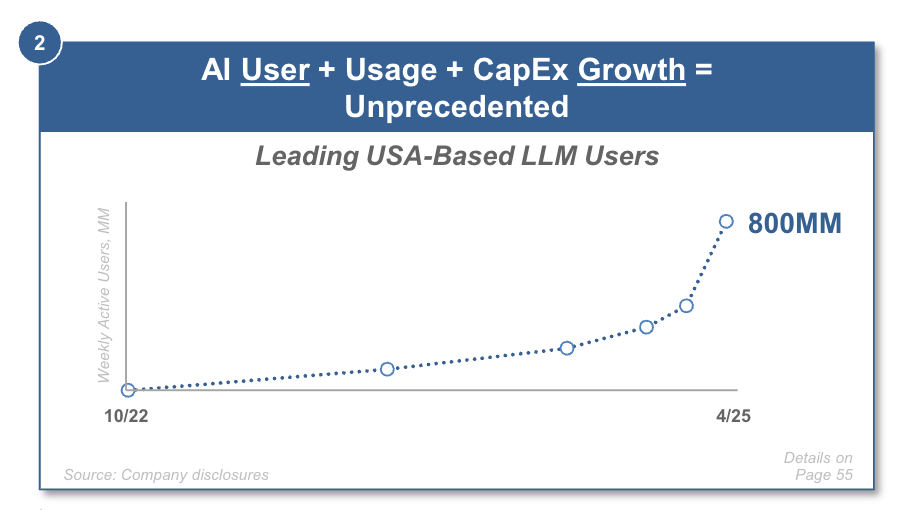


Artificial intelligence innovation: Lessons from sector leaders
Key Takeaways
An AI report suggests engineers and manufacturers must embrace AI at scale to keep pace with sector leaders that are more aggressively embracing innovation.The 2025 AI report from Bond has made three trends clear:
- AI adoption is happening at such an unprecedented rate that AI is now in the embedding stage and future-state predictions must be considered reliable.
- Major players in sectors such as agriculture, mining and biology are cited as moving quickly, with adoption moving past digital and office work and entering the physical realm. These industries face similar challenges, compared to most manufacturers, when it comes to AI adoption. Being in a physical industry is no longer an excuse to be behind.
- For the manufacturing sector, the opportunity is to act now. Engineers and manufacturers must embrace AI at scale to keep pace with fast-moving competitors in their own sectors.
This article covers the following areas:
- AI in manufacturing: Why adoption now determines whether companies will lead the sector or fall behind
- From hype to integration: What the Bond AI Report means for manufacturing
- AI wake-up call: Lessons from agriculture, mining, and IT adoption
The AI race is here, in every industry: act now or fall behind
“The distinction between digital and physical infrastructure continues to blur.”
That’s a central idea in a new artificial intelligence report from BOND, a San Francisco–based investment firm. Large businesses and sectors are now embedding AI into products and rolling out copilots, assistants, and agents that fundamentally change how work gets done. Industry leaders across sectors have moved AI to the core of businesses. They’re not just experimenting any more.
The report spans present-state AI adoption through future-state predictions. For manufacturing in particular, the message has become urgent. We have all heard AI hype by now, but the report details just how swiftly AI is embedding itself across industries.
Companies in agriculture, mining, and IT are cited as rapidly scaling adoption. At CoLab, we see this report as both validation and a call to action. It validates what we already know: that AI already has leaders in major sectors. In doing so it challenges the entire manufacturing field to embrace this shift at scale.
What the Bond report tells us about AI
Report writer Mary Meeker has long been recognized for her ability to spot inflection points in technology.
Key findings in this report include:
- AI adoption is unprecedented. No other technology has scaled this quickly. Consider how quickly LLM adoption has happened:

- We are in the “embedding” stage. The phase of curiosity and consideration is over. Large incumbents are embedding AI into products and rolling out copilots, assistants, and agents that fundamentally change user experience.
- The future-state is predictable, not speculative. The report suggests that AI will drive research, engineering, education, and logistics workflows with little to no human oversight. It argues this point by spelling out that there is nothing now that suggests AI development will slow down, which means future-state predictions are increasingly likely to actually occur.
The Bond report argues there is nothing that suggests AI development will slow, which means future-state predictions are increasingly likely to occur. That means they must be prepared for today.
Manufacturing and AI: where we stand
The report doesn’t call out manufacturing as a leading sector for AI adoption. While some manufacturers are embedding AI into the products they offer customers, few have implemented AI in ways that meaningfully transform core processes internally. But crucially, the sector leaders called out in the Bond Report are using AI in the heart of their operations.
To achieve that, manufacturing companies must embed AI in two functions: engineering and production.
Looking forward, and going beyond the Bond report, we believe that AI will take its place at the center of engineering organizations. Instead of acting as a back-end support or helpful in specific situations, AI will ultimately become a collaborator: contributing ideas, proposing solutions and accelerating decisions.
Today, AI is ready to handle repetitive, administrative tasks that slow teams down across sectors. At CoLab, we’ve chosen design review as the entry point. AI can apply standards, identify repeat errors, and flag issues based on prior work. When deployed carefully, it “remembers” and learns from past experience, much like a skilled engineer. Overall, design review represents a high-value, low-disruption workflow. The kind perfectly suited to AI disruption.
But that’s just the beginning.
The urgency of AI adoption
The Bond report puts it plainly: “AI is a compounder—on internet infrastructure, which allows for wicked-fast adoption of easy-to-use broad-interest services.”
Why has AI moved faster than any prior technology? Four reasons stand out:
- Low development costs. Building AI tools is less capital-intensive than previous waves of technology.
- Mass interest and demand. Adoption has been driven by users who see immediate, tangible value.
- Accessibility. AI tools are intuitive and easy to use, lowering barriers to entry.
- Industry investment. Entire sectors are mobilized behind accelerating AI adoption.
The combination of low cost, broad interest, easy usability, and strong backing has created a perfect storm for rapid adoption. Proof points are everywhere:
- Large language models expanding across domains.
- The cost to deliver AI is collapsing.
- Massive increases in AI-based IT roles compared to non-AI roles
- Real-world examples like autonomous taxis moving from pilot programs to real-world use.
These points should encourage engineering leaders. With high-value, low-disruption use cases, backed by a strong AI strategy, engineers can be leaders within AI adoption.
Industry comparisons: agriculture and mining lead the way
The Bond report highlights sector leaders already achieving measurable results with AI. Two of the most notable examples come from agriculture and mining:
- Agriculture: Tools like LaserWeeding eliminate 200,000 weeds across two acres per hour. AI-guided grazing systems “remember” which land has been used, optimizing resource efficiency.
- Mining: KoBold’s Machine Prospector combines geochemical, geophysical, and geological data with statistical models to pinpoint promising exploration sites.
These examples share two things in common: they address specific, real-world problems and they deliver measurable improvements. That’s exactly how AI adoption should be framed for engineers.
The question is not whether engineering teams and manufacturing can adopt AI, but how quickly they will act to keep pace with other advancing industries.
Applying the lessons to manufacturing
Manufacturing has the same opportunity to use AI in practical ways that solve real pain points. The Bond report highlights sectors like agriculture and mining, where AI has already delivered measurable results by targeting specific inefficiencies.
- One example is design review during the product development process. Just as agriculture uses AI to identify and eliminate weeds at scale, design review can benefit from AI spotting recurring errors and applying standards automatically. At CoLab, we’ve focused here because it’s a high-value, low-disruption workflow, which is the same entry point the Bond report suggests is most effective.
- Another example is data use. Mining companies like KoBold are applying AI to vast, complex datasets to uncover new opportunities. In a similar way, engineers can harness accumulated design data to surface insights that help make better decisions
Finally, broad collaboration is essential. The report emphasizes that successful AI adoption requires context and integration. CoLab achieves context and integration through a platform that combines virtual design reviews with subject experts (suppliers, engineers, manufacturing) with AI that learns from all of their feedback. The result is not just faster reviews, but AI trained on a richer, more representative base of experience.
These examples show that the principles in the Bond report are not abstract. They can — and already do — apply directly to engineering workflows. The question is not whether engineering teams and manufacturing can adopt AI, but how quickly they will act to keep pace with other advancing industries.
The advanced adoption frontier: engineering lessons from biology
The Bond report points to molecular engineering as one of the most advanced frontiers of AI adoption. In structural biology, large-scale models are now predicting protein properties and designing new molecules at a pace that traditional lab work could never match. The result is a step change: faster discovery, lower costs, and breakthroughs that were previously out of reach.
For manufacturing, the lesson is clear. AI isn’t only about trimming admin tasks or supporting back-office functions. Just as AI has become central to molecular design, it can become central to how we simulate, design and manufacture products. The same principles apply: embedding AI into the heart of workflows, not just at the edges, is what delivers transformation.
This is the warning and the opportunity. If biology can reinvent its methods by trusting AI to lead at the molecular level, then engineering must be prepared to do the same at the physical and industrial level. Waiting means lagging, but embedding AI now means accelerating innovation across the entire product lifecycle.
The future state of AI in manufacturing: can we get there?
The Bond report paints a picture of what’s next:
“Rather than executing pre-programmed tasks, AGI systems would understand goals, generate plans, and self-correct in real time. They could drive research, engineering, education, and logistics workflows with little to no human oversight—handling ambiguity and novelty with general-purpose reasoning.”
That future may sound bold, but the justification is already here. Because there is no evidence of a potential slowdown, the only rational assumption is that the rapid acceleration and development continues.
For manufacturing, the true question is about leading, keeping pace or lagging the field. If we do not act as a sector, it’s clear that choice will be made for us.
Although we work to manufacture products, what we make always begins with engineering. It cannot come first in the process but lag behind manufacturing and industry and expect to remain relevant. Engineering comes first in the process and needs to embrace AI adoption and deployment to remain there.
A call to action
Our field is defined by problem-solving, optimization and innovation, which are exactly the traits that AI enhances.
The BOND report shows that industry leaders are scaling AI now, with measurable outcomes already in hand. For engineers and manufacturers, the work is to accelerate adoption and embed AI into daily workflows.
At CoLab, we’re committed to this vision. By building tools like AutoReview and our Design Engagement System, we’re making AI practical, accessible, and valuable today, while preparing for the future state described in the Bond report.
We agree with the report’s conclusion that AI is no longer speculative. It’s here, it’s accelerating, and it’s embedding itself across every sector. Agriculture and mining leaders are proof that industries willing to adopt at scale can unlock transformative outcomes.
At CoLab, we believe the path forward is clear. The urgent work of embedding AI in your organization begins now so that engineers can focus on solving the hardest problems, building better products, and shaping the future at the speedy rate it is coming at us.






